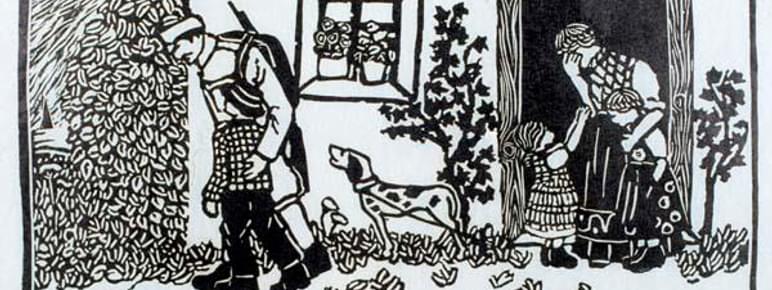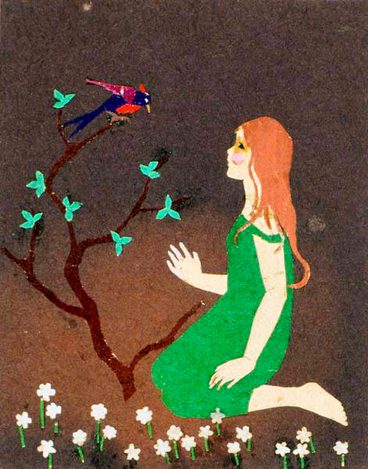
Collections in the NAEA
The NAEA holds significant sets of materials that reveal the conditions of art education and teaching in the 19th and 20th centuries. The dynamic and radical changes in thinking and practice during this period influenced both the nature and future direction of art education and curriculum development. Some of the highlights of the archive are listed below.
View a full list of all collections held by the NAEA
In 1956 the Society for Education through Art (SEA) held a conference at Bretton Hall chaired by Sir Herbert Read. This seminal event debated the fundamentally opposing values and concerns that were central to the Child Art and Basic Design movements. Records of this pivotal debate and correspondence between Alexander Barclay-Russell and Sir Herbert Read provide an important research focus within the archive. The Core Collections not only provide evidence of significant ‘movements’ and intellectual tensions during this period but also give an historical context for the evolution and reformation of art education in schools and colleges.
CORE COLLECTIONS
Franz Cizek Collection
This collection contains over 100 drawings, paintings and prints by children in Franz Cizek’s Juvenile Art Classes in Vienna during the 1920s. The work was first exhibited in London in 1921 by Francesca Wilson, a Birmingham teacher. This and subsequent exhibitions under the auspices of Save the Children Fund, had a great influence on art educationalists such as Marion Richardson and inspired many of the ideas associated with the Child Art Movement.
Cizek’s work was promoted in England by Francesca Wilson and the later writings of Wilhelm Viola, whose advocacy assured Cizek’s position as an innovator in his teaching methods and as an agent for change in the recognition of the value of child art. The collection also includes papers, letters, books, catalogues and other material relating to the work of Franz Cizek.

People make a great mistake in thinking of child art merely as a step to adult art. It is a thing in itself, quite shut off and isolated, following its own laws and not the laws of grown up people.
- Franz Cizek, 1921
Basic Design Collections
These collections demonstrate a significant shift in thinking and practice in art education and training in the post war period into the 1950s and 1960s. The genesis of the principles and teaching methods evidenced here can be traced to Johannes Itten’s Basic Course at the Bauhaus in Germany in the 1920s and the ‘ordered process of learning’ promoted by artist educators such as Paul Klee.
The Basic Design methods developed by innovative and influential artist lecturers such as Victor Pasmore, Richard Hamilton, Tom Hudson, Maurice de Sausmarez, Harry Thubron and others informed the ‘Developing Process’ and the “Continuing Process” from 1955–1965 and beyond.
Basic Design thinking is well represented in the NAEA. The body of the collections is drawn from an exhibition 'The Continuing Process' held at the Institute of Contemporary Art (ICA) London in 1981, collected by David Thistlewood from the British Art and Design Education Archive at the University of Liverpool.
The collections reflect not only the changing conditions and attitudes but also a direct challenge to the ‘progressivists’. What emerged from this 'new creativity' was an emphasis on analytical thinking and visual education that permeated over the succeeding decade from art schools to secondary schools and the shaping of teaching syllabi. The collections are supported by texts relating to the development of this movement and to the ICA exhibition.
No matter how daubed and glaring the colours. The question is not whether the child is producing good drawings. The question is whether it is developing its faculties.
- Herbert Spencer, 1820–1903
Child Art Collections
These collections constitute a portmanteau of children’s work and documentary evidence that underpinned the Child Art Movement in the 1930s and 1940s. These images and papers provide an insight into the ‘progressive’ principles that were to shape and inform the New Art Teaching and the way in which intrinsic values and motivations present in the drawings and paintings by children were recognised and encouraged.
These principles are represented in the Alexander Barclay-Russell Memorial Exhibition ‘Revolution in Child Art 1930–1960’ exhibited at the Festival Hall, London in 1983, which forms a part of the Barclay-Russell collection. Barclay–Russell was an accomplished artist, teacher, visionary and national figure in the realm of art education. He collected several thousand examples of children’s creative work , many of which are held in the archive.
There is also work from Inner London Education Authority (ILEA) and its predecessor London County Council (LCC). This is a record of art educational activities and teaching in London between 1900–1960 that reflects the preoccupations and methods of educationalists and teachers such as Marion Richardson, Veronica Zabel, Nan Youngman, Audrey Martin and others closely associated with the Society for Education through Art (SEA).
Learning Through Drawing Collection
The Learning Through Drawing Collection contains drawings from infant, primary and secondary schools brought together by the North East Region Art Advisers Association in an exhibition in 1978. As well as the drawings the collection is contextualised by a booklet which accompanied the exhibition. The original aim of the project was to ‘draw attention to the significance of drawing in the education of children, by increasing understanding about drawing and illustrating its wide range and function’.
The drawings were exhibited in over 30 centres and venues in England and Wales including at the Plowden Conference 1979, the opening of the new gallery at the Institute of Education, London University and the 1981 International Society for Education in Art (INSEA) World Congress in Rotterdam.
The emergent ideas redefined attitudes and approaches to drawing in education in the period preceding the National Curriculum, serving also as an influential precursor to future initiatives such as The Campaign for Drawing.
Sir Alec Clegg & The West Riding Collections
The influence of Sir Alec Clegg in the development of arts education and founding Bretton Hall as a training centre for teachers of the arts in 1949 had a profound impact on the way in which the arts were regarded, taught and promoted in schools. His time as Chief Education officer for the West Riding of Yorkshire (1945–1974) saw the arts elevated to a position of influence and special relevance in the education of children. His philosophy and mediation provided the impulse and direction for teachers to fully support the development of children’s emotional and sensory needs through the arts. This is perhaps best summed up in the oft quoted aphorism which hung on his aunt’s sitting room wall:
‘If thou of fortune be bereft
And of thine earthly store hath left two loaves
Sell one and with the dole
Buy hyacinths to feed the soul’.
The West Riding and related collections were compiled by Sir Alec Clegg, advisers and teachers during this period and provide a record of work showing quality and achievement from primary and secondary schools in the region.

